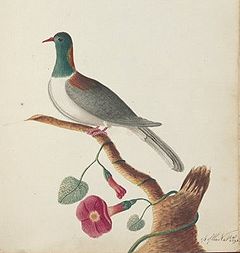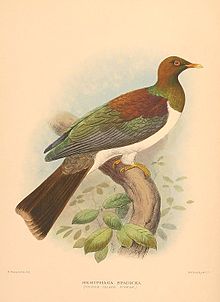- Norfolk Island Pigeon
-
Norfolk Island Pigeon 
Sketch from John Hunter's Birds & flowers of New South Wales drawn on the spot in 1788, '89 & '90 Conservation status Scientific classification Kingdom: Animalia Phylum: Chordata Class: Aves Order: Columbiformes Family: Columbidae Genus: Hemiphaga
Bonaparte, 1854Species: H. novaeseelandiae Subspecies: H. n. spadicea Trinomial name Hemiphaga novaeseelandiae spadicea
Latham, 1802The Norfolk Island Pigeon (Hemiphaga novaeseelandiae spadicea), sometimes called a Wood Quest, was a subspecies of the New Zealand Pigeon that inhabited Norfolk Island. It went extinct around the turn of the 20th century.
Contents
Ecology
The abundance of the Norfolk Island Pigeon at the time of the island's settlement is unknown. Early records indicate the presence of the bird, but do not contain any information on its numbers. Based on the behaviour of the other subspecies, it is likely that the bird relied upon fruiting plants for food.[1]
Extinction
The extinction of the Norfolk Island Pigeon was caused by a combination of the introduction of cats and weasels, habitat destruction by human settlers, and direct hunting by humans. Prior to European settlement, the bird had been hunted by the Polynesian settlers of the island. When Europeans reached the island, however, the birds remained and the Polynesians did not.[2] The Europeans took up the bird as a food source. An officer of the penal colony there, Ensign Abel Dottin William Best, recorded the species as still quite common in 1838, with his journals mentioning his successful hunting of 72 birds, including 25 on September 18th, 1838.[3] The last sighting occurred in 1901.[4] Direct hunting by humans was likely the dominant cause of extinction.[1]
Specimens
The first description of the species was given by John Latham, in his 1802 work Supplementum Indicis Ornithologici.[5] Twenty specimens of the Norfolk Island Pigeon are known. Three of these are in the Natural History Museum, Leiden.[6]
Memorials
The Government of Norfolk Island released a stamp commemorating the bird on February 24th, 1971.[7]
References
- ^ a b Stephen T. Garnett and Gabriel M. Crowley (2000). "New Zealand Pigeon (Norfolk Island)". The Action Plan for Australian Birds 2000. Environment Australia. http://www.environment.gov.au/biodiversity/threatened/publications/action/birds2000/pubs/nz-pigeon.pdf. Retrieved 2008-12-08.
- ^ Richard N. Holdaway & Atholl Anderson (2001). "Avifauna from the Emily Bay Settlement Site, Norfolk Island:A Preliminary Account". Records of the Australian Museum 27: 85–100. doi:10.3853/j.0812-7387.27.2001.1343. http://www.amonline.net.au/pdf/publications/1343_complete.pdf. Retrieved 2008-12-10.
- ^ James L. Moore (December 1985). "Ensign Best's bird observations on Norfolk Island". Notornis (Ornithological Society of New Zealand) 32: 319–322. http://www.notornis.org.nz/free_issues/Notornis_32-1985/Notornis_32_4.pdf. Retrieved 2008-12-10.
- ^ Day, David (1989). The Encyclopedia of Vanished Species. Hong Kong: Mclaren Publishing Limited. ISBN 0947889302.
- ^ R. Schodde, Australia Bureau of Flora and Fauna, I. J. Mason, Australian Biological Resources Study, W. W. K. Houston, A. Well (1997). Zoological Catalogue of Australia. CSIRO Publishing. p. 53. ISBN 0643060375.
- ^ "Naturalis - Extinct bird: Hemiphaga novaeseelandiae spadicea (Norfolk Island Pigeon)". Nationaal Natuurhistorisch Museum. http://nlbif.eti.uva.nl/naturalis/detail.php?lang=uk&id=41. Retrieved 2008-12-08.
- ^ "Bird Stamps Related To Captain James Cook". Captain Cook Society. 2005. http://www.captaincooksociety.com/ccsu33part3.pdf. Retrieved 2008-12-10.
External links
Categories:- IUCN Red List extinct species
- Extinct birds
- Fauna of Norfolk Island
- Birds of Australia
- Treroninae
- Animals described in 1802
Wikimedia Foundation. 2010.



